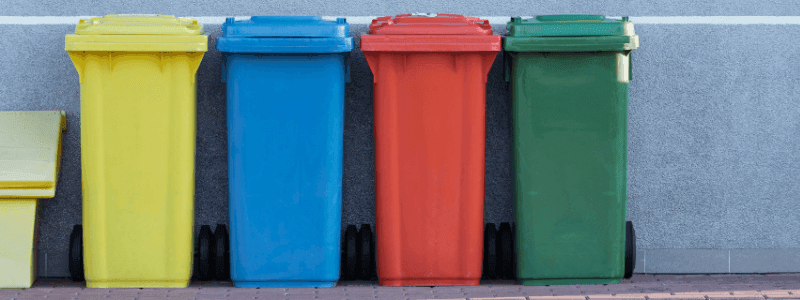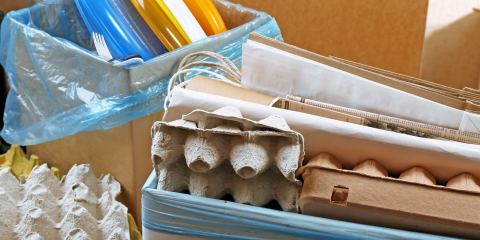When you are moving, there are lots of things to deal with—changing your address, organizing and packing your belongings, cleaning, and scheduling movers, just to name a few.
One thing that you may not be prepared for is how much waste you’re going to produce before, during, and after you pack and move. From the first belonging decluttered to the last item unpacked, you will end up needing some kind of garbage management system just to stay on top of it all.
Packing before your move
One of the best ways to get a jump on managing your waste is to start planning for it before you even start packing. Carefully selecting which packing materials to use and which belongings to bring with you are two of the easiest ways to reduce packaging waste and begin the garbage management process early.
Packing materials
To cut back on the amount of packing materials needed, you should consider using or renting reusable plastic bins for packing your items, and sticking to cushioning materials that can be repurposed (like fabrics) or recycled easily, such as:
- String instead of plastic twine
- News- and packing paper instead of foam packing peanuts
- Recyclable or biodegradable bubble wrap and air pillows
PRO TIP: While magazine and newspaper make excellent packing material, be careful when wrapping your belongings with them. Their ink can run and stain or mark light colored items, so it is best to save these materials for cushioning and use plain packing- or tissue paper for wrapping.
If you are picking up second-hand packing materials from stores, friends or family, or from online resources, check that they are in good enough condition to securely hold your belongings:
- Cardboard boxes should be free of rips, cuts, and dents, with little to no wear on the flaps and corners.
- Newspaper should not be crushed.
- Bubble wrap should have close to 100% of their bubbles intact.
Declutter and reduce
Once you have your packing materials, you can start sorting through everything you own and getting rid of anything you no longer use, need, or want. This will limit the amount of packaging materials you need to move and cut back on the amount of waste produced after unpacking. If you have a considerable amount of furniture and equipment to get rid of, you may want to consider renting a bin from a junk removal specialist.

Unpacking after your move
It’s easy to underestimate the amount of packing materials you use when packing your house, leaving you with an unexpected mountain of crumpled paper, used bubble wrap, and flattened boxes to deal with when you’re unpacking in your new home. Keep your post-move waste under control with these tips:
Get organized
Before you start unpacking, set up your recycling and waste bins in the room you will be working in. Arrange your bins into two groups:
- One for materials that are in good enough condition to be reused, donated, or sold.
- One for items that need to be disposed of.
The first group can be piled neatly together into one box. The second group should have designated bins or bags for each of the following items:
- Cardboard
- Paper
- Recyclable hard plastics and other containers
- Plastic bags and bubble wrap
- Biodegradable/compostable materials, such as string or twine
- Garbage
If you don’t have enough space or enough bins to set up a station like this, place them all in one or two boxes and sort them into these categories afterwards.
PRO TIP: Make sure to check your new municipality’s recycling bylaws to confirm what items can be recycled and what can’t. If you don’t have the collection calendar for your new home, this information can often be found on town or city websites.
As you unpack:
- Break down and bundle up any cardboard boxes or sheets.
- Flatten out and bundle any crumpled news- or packing paper that will go into your recycle bins.
- If you have so many crumpled pages that it’s too time-consuming to flatten, pile them into a box or bag and step on it to compact it, and take the box(es) directly to the recycling center.
- Crush or flatten any aluminum or plastic materials to save space. For plastic materials, check the stamped recycling classification code if you aren’t sure if it is recyclable. If it’s not, place it in the garbage bin.
- Throw out any bubble wrap that has more than 5% of the bubbles popped, as it will no longer cushion materials safely.
- Carefully set aside, wrap, and label any broken items that will be disposed of.
PRO TIP: As you sort garbage into bags, be mindful of the weight. Most municipalities have weight limits for trash bags—often around 40 to 50 lbs—and any items over the limit will be left at the curb. Not to mention that if you don’t have high quality bags, they will likely tear under the weight.
Disposal
Donate or resell any unused or gently-used packing materials. You can post their availability on your social media accounts, Facebook Marketplace, Craigslist, and any other neighborhood freecycling apps. For items that aren’t in good enough condition to reuse, the next step is recycling:
- If you don’t have too much waste, you can make use of your building’s garbage room or dumpster, or the curbside collection program in your area.
- If you have lots of waste, don’t overload shared garbage areas with your trash. Check for bulk collection days coming up, or if you have room to house the bins and bags, you can space out your garbage over the span of a few collection days. If this isn’t an option, or if you have large, bulky or heavy items to dispose of, take your garbage to a dump, landfill, or recycling center in your area.
PRO TIP: Some landfills charge a fee for each bag, by the truckload, or by weight, so check a few different locations to find the best price for the amount of garbage you have.
Conclusion
Taking a little bit of time to get organized and make garbage disposal easier means less work for you at the end of a long day, and can leave you feeling like you’ve accomplished more—after all, there’s nothing better than finishing setting up your room and having the garbage ready for quick removal after a move. You can manage garbage through the unpacking process by following these steps:
- Decrease the amount of waste your move produces by decluttering your belongings before you start packing
- After you move, set up a waste station in the room you are unpacking in
- Come up with a plan for garbage disposal:
- Recycle all recyclable items
- Space out garbage over a few collection days
- Rent a junk removal container
- Take your trash to the local landfill
Ultimate Moving Guide
Plan your move from A to Z with our expert advice.




